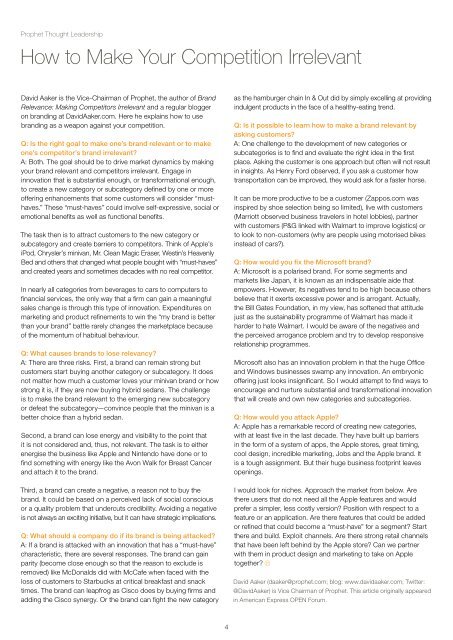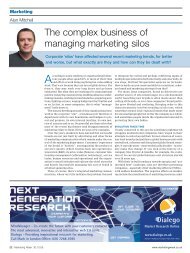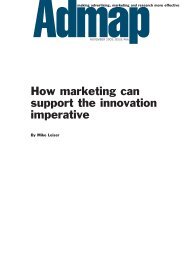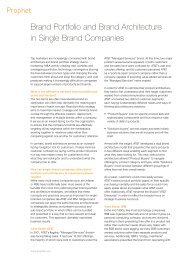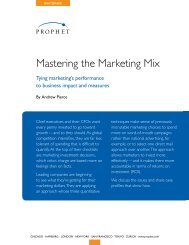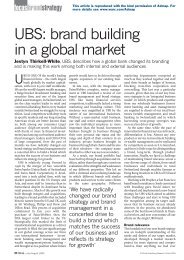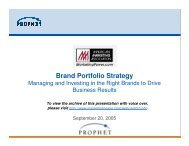INSPIRED AND ACTIONABLE IDEAS - Prophet
INSPIRED AND ACTIONABLE IDEAS - Prophet
INSPIRED AND ACTIONABLE IDEAS - Prophet
Create successful ePaper yourself
Turn your PDF publications into a flip-book with our unique Google optimized e-Paper software.
<strong>Prophet</strong> Thought Leadership<br />
How to Make Your Competition Irrelevant<br />
David Aaker is the Vice-Chairman of <strong>Prophet</strong>, the author of Brand<br />
Relevance: Making Competitors Irrelevant and a regular blogger<br />
on branding at DavidAaker.com. Here he explains how to use<br />
branding as a weapon against your competition.<br />
Q: Is the right goal to make one’s brand relevant or to make<br />
one’s competitor’s brand irrelevant?<br />
A: Both. The goal should be to drive market dynamics by making<br />
your brand relevant and competitors irrelevant. Engage in<br />
innovation that is substantial enough, or transformational enough,<br />
to create a new category or subcategory defined by one or more<br />
offering enhancements that some customers will consider “musthaves.”<br />
These “must-haves” could involve self-expressive, social or<br />
emotional benefits as well as functional benefits.<br />
The task then is to attract customers to the new category or<br />
subcategory and create barriers to competitors. Think of Apple’s<br />
iPod, Chrysler’s minivan, Mr. Clean Magic Eraser, Westin’s Heavenly<br />
Bed and others that changed what people bought with “must-haves”<br />
and created years and sometimes decades with no real competitor.<br />
In nearly all categories from beverages to cars to computers to<br />
financial services, the only way that a firm can gain a meaningful<br />
sales change is through this type of innovation. Expenditures on<br />
marketing and product refinements to win the “my brand is better<br />
than your brand” battle rarely changes the marketplace because<br />
of the momentum of habitual behaviour.<br />
Q: What causes brands to lose relevancy?<br />
A: There are three risks. First, a brand can remain strong but<br />
customers start buying another category or subcategory. It does<br />
not matter how much a customer loves your minivan brand or how<br />
strong it is, if they are now buying hybrid sedans. The challenge<br />
is to make the brand relevant to the emerging new subcategory<br />
or defeat the subcategory—convince people that the minivan is a<br />
better choice than a hybrid sedan.<br />
Second, a brand can lose energy and visibility to the point that<br />
it is not considered and, thus, not relevant. The task is to either<br />
energise the business like Apple and Nintendo have done or to<br />
find something with energy like the Avon Walk for Breast Cancer<br />
and attach it to the brand.<br />
Third, a brand can create a negative, a reason not to buy the<br />
brand. It could be based on a perceived lack of social conscious<br />
or a quality problem that undercuts credibility. Avoiding a negative<br />
is not always an exciting initiative, but it can have strategic implications.<br />
Q: What should a company do if its brand is being attacked?<br />
A: If a brand is attacked with an innovation that has a “must-have”<br />
characteristic, there are several responses. The brand can gain<br />
parity (become close enough so that the reason to exclude is<br />
removed) like McDonalds did with McCafe when faced with the<br />
loss of customers to Starbucks at critical breakfast and snack<br />
times. The brand can leapfrog as Cisco does by buying firms and<br />
adding the Cisco synergy. Or the brand can fight the new category<br />
as the hamburger chain In & Out did by simply excelling at providing<br />
indulgent products in the face of a healthy-eating trend.<br />
Q: Is it possible to learn how to make a brand relevant by<br />
asking customers?<br />
A: One challenge to the development of new categories or<br />
subcategories is to find and evaluate the right idea in the first<br />
place. Asking the customer is one approach but often will not result<br />
in insights. As Henry Ford observed, if you ask a customer how<br />
transportation can be improved, they would ask for a faster horse.<br />
It can be more productive to be a customer (Zappos.com was<br />
inspired by shoe selection being so limited), live with customers<br />
(Marriott observed business travelers in hotel lobbies), partner<br />
with customers (P&G linked with Walmart to improve logistics) or<br />
to look to non-customers (why are people using motorised bikes<br />
instead of cars?).<br />
Q: How would you fix the Microsoft brand?<br />
A: Microsoft is a polarised brand. For some segments and<br />
markets like Japan, it is known as an indispensable aide that<br />
empowers. However, its negatives tend to be high because others<br />
believe that it exerts excessive power and is arrogant. Actually,<br />
the Bill Gates Foundation, in my view, has softened that attitude<br />
just as the sustainability programme of Walmart has made it<br />
harder to hate Walmart. I would be aware of the negatives and<br />
the perceived arrogance problem and try to develop responsive<br />
relationship programmes.<br />
Microsoft also has an innovation problem in that the huge Office<br />
and Windows businesses swamp any innovation. An embryonic<br />
offering just looks insignificant. So I would attempt to find ways to<br />
encourage and nurture substantial and transformational innovation<br />
that will create and own new categories and subcategories.<br />
Q: How would you attack Apple?<br />
A: Apple has a remarkable record of creating new categories,<br />
with at least five in the last decade. They have built up barriers<br />
in the form of a system of apps, the Apple stores, great timing,<br />
cool design, incredible marketing, Jobs and the Apple brand. It<br />
is a tough assignment. But their huge business footprint leaves<br />
openings.<br />
I would look for niches. Approach the market from below. Are<br />
there users that do not need all the Apple features and would<br />
prefer a simpler, less costly version? Position with respect to a<br />
feature or an application. Are there features that could be added<br />
or refined that could become a “must-have” for a segment? Start<br />
there and build. Exploit channels. Are there strong retail channels<br />
that have been left behind by the Apple store? Can we partner<br />
with them in product design and marketing to take on Apple<br />
together?<br />
David Aaker (daaker@prophet.com; blog: www.davidaaker.com; Twitter:<br />
@DavidAaker) is Vice Chairman of <strong>Prophet</strong>. This article originally appeared<br />
in American Express OPEN Forum.<br />
4


